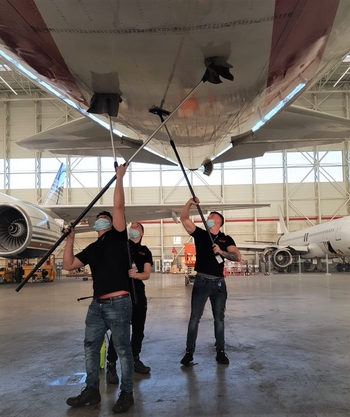The new art of aircraft washing

Wash, please! From top to toe, or just the lower, particularly smeared part of the fuselage.
Orders like these are everyday practice at THOMS Aviation. In cooperation with its Frankfurt-Hahn-based MRO provider, HAITEC Aircraft Maintenance, the THOMS team cleans all types of aircraft, from B737 to B747. Currently, there are 4 aircraft waiting to be washed: a B747-400F, an A340 P2F conversion, a B777F, and a B737-400F. “To fully clean a B747 takes about 150 man-hours,” THOMS Aviation CEO, Thomas de Boer, explains while pointing out his son, Sasha, who is team leader and supervisor. Once an airline has placed an order “we rush from the Netherlands, where we all live, to HAITEC’s large hangar at Hahn airport to accomplish the job,” Sasha says. “Armed” with telescopic poles, they commence cleaning and polishing the hull of the jetliner.
Dry cleaning vs. water washing with high pressure
The Dry Wash method requires a lot of physical effort from the employees but offers a number of different advantages to THOMS Aviation. “And not only to us, but also to our airline customers and the environment,” Thomas De Boer underlines. For example, massively reduced water consumption due to the scrubbing method using special pads and polishing cloths. “We only need about 80 liters, including liquid detergents, to completely clean a B747 freighter,” he illustrates. Only certain detergents approved by Boeing and Airbus may be used for this purpose, because cleaning agents from the supermarket could cause paint damage to the aircraft.

Clean aircraft require less fuel
There is hardly any waste because the pads used for cleaning can be washed and then re-used around 60 times. An aircraft requires washing about every three months, because oil and grease splashes which are released when the landing gear is extended, settle, especially on the fuselage. Tire wear, dust and other dirt particles are added, which then mix to form a dark layer that sticks to the underside of the fuselage. In this respect, regularly cleaning an aircraft also contributes to environmental protection, since, once freed from the dirt crust, an aircraft consumes up to 5% less kerosene because of the significantly lower air resistance, manager De Boer calculates, referring to measurements.

Two product lines
THOMS Aviation offers two products to airline customers: THOMS ProClean, which offers a basic cleaning service, and THOMS DryWash Polish, which is a package with additional services such as the application of polish to better protect the aircraft fuselage.
Another advantage of the Dry Wash method is that aircraft do not have to be towed into a hangar. “We can clean aircraft just as well on the apron, which is less costly for the operator and reduces downtime,” says Thomas De Boer. Also, parking spaces there do not have to be reserved in advance. However, in winter, a parking space in the hangar certainly is a more pleasant option for the cleaners.
Building new stations
Speaking of personnel: It is difficult to get them; there are simply too few people. Especially around Hahn Airport, with its rural structure, labor is scarce. Therefore, THOMS Aviation employees often shuttle from Amsterdam, the company's headquarters, to the airport in western Germany as soon as more extensive work requires it.
After a 6-month test phase, the company is now planning to set up its own station at Hahn, Marcel Jansen announces. The former KLM manager is the Managing Director of FRONTROW Aviation, and, as a business partner, responsible for THOMS Aviation’s development strategy. “We also have Barcelona, Cologne, Stockholm, and Budapest on the agenda,” Thomas De Boer adds. However, finding trained personnel with a no-nonsense mentality remains being a challenge. This applies to Frankfurt-Hahn, Amsterdam and in general. “But we are very happy with our current headcount,” the manager emphasizes.
Aviation and more
In addition to the expansion of business activities in the aviation sector, Marcel Jansen sees further fields of activity for the cleaning company: “Many freight and passenger trains are sprayed full of graffiti, trucks and buses often are, too. We have developed an ecologically based wax with which graffiti can be washed off easily, with a minimal amount of water and without using aggressive solvents.”
In the long run, perhaps buses, trains, airport air bridges, or trucks will even be the main fields of action for the DryWash specialists from the Netherlands.
Heiner Siegmund - Cargo forwarder
13. February 2022
Link to article: https://www.cargoforwarder.eu/2022/02/13/the-new-art-of-aircraft-washing/
